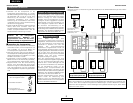
ENGLISH
39
Additional Information Additional Information
ENGLISH
[2] DTS Digital Surround
Digital Theater Surround (also called simply DTS) is a multi-
channel digital signal format developed by Digital Theater
Systems.
DTS offers the same “5.1” playback channels as Dolby Digital
(front left, front right, center, surround left and surround right) as
well as the stereo 2-channel mode. The signals for the different
channels are fully independent, eliminating the risk of
deterioration of sound quality due to interference between
signals, crosstalk, etc.
DTS features a relatively higher bit rate as compared to Dolby
Digital (1234 kbps for CDs and LDs, 1536 kbps for DVDs) so it
operates with a relatively low compression rate. Because of this
the amount of data is great, and when DTS playback is used in
movie theaters, a separate CD-ROM synchronized with the film
is played.
With LDs and DVDs, there is of course no need for an extra disc;
the pictures and sound can be recorded simultaneously on the
same disc, so the discs can be handled in the same way as discs
with other formats.
There are also music CDs recorded in DTS. These CDs include
5.1-channel surround signals (compared to two channels on
current CDs). They do not include picture data, but they offer
surround playback on CD players that are equipped with digital
outputs (PCM type digital output required).
DTS surround track playback offers the same intricate, grand
sound as in a movie theater, right in your own listening room.
2 DTS compatible media and playback methods
Symbols indicating DTS compatibility: and
The following are general examples. Also refer to the player’s
operating instructions.
1: DTS signals are recorded in the same way on CDs and LDs
as PCM signals. Because of this, the un-decoded DTS
signals are output as random “hissing” noise from the CD
or LD player’s analog outputs. If this noise is played with
the amplifier set at a very high volume, it may possibly
cause damage to the speakers. To avoid this, be sure to
switch the input mode to “AUTO” or “DTS” before playing
CDs or LDs recorded in DTS. Also, never switch the input
mode to “ANALOG” or “PCM” during playback. The same
holds true when playing CDs or LDs on a DVD player or
LD/DVD compatible player. For DVDs, the DTS signals are
recorded in a special way so this problem does not occur.
2: The signals provided at the digital outputs of a CD or LD
player may undergo some sort of internal signal processing
(output level adjustment, sampling frequency conversion,
etc.). In this case the DTS-encoded signals may be
processed erroneously, in which case they cannot be
decoded by the AVR-1306, or may only produce noise.
Before playing DTS signals for the first time, turn down the
master volume to a low level, start playing the DTS disc,
then check whether the DTS indicator on the AVR-1306
( page 23) lights before turning up the master volume.
3: A DVD player with DTS-compatible digital output is required
to play DTS DVDs. A DTS Digital Output logo is featured on
the front panel of compatible DVD players. Recent DENON
DVD player models feature DTS-compatible digital output –
consult the player’s owner’s manual for information on
configuring the digital output for DTS playback of DTS-
encoded DVDs.
MANUFACTURED UNDER LICENSE FROM DIGITAL THEATER
SYSTEMS, INC.
U.S. PAT. NO. 5,451,942; 5,956,674; 5,974,380; 5,978,762
AND OTHER WORLD-WIDE PATENTS ISSUED AND PENDING.
“DTS” AND “DTS DIGITAL SURROUND” ARE REGISTERED
TRADEMARKS OF DIGITAL THEATER SYSTEMS, INC. ©
1996, 2000 DIGITAL THEATER SYSTEMS, INC. ALL RIGHTS
RESERVED.
Playback method (reference
page)
Dolby Digital output
terminals
Media
CD
LD (VDP)
DVD
Optical or coaxial digital
output
(same as for PCM)
2
Optical or coaxial digital
output
(same as for PCM)
2
Optical or coaxial digital
output
(same as for PCM)
3
Set the input mode to “AUTO”
or “DTS” ( page 18, 19).
Never set the mode to
“ANALOG” or “PCM”.
1
Set the input mode to “AUTO”
or “DTS” ( page 18, 19).
Never set the mode to
“ANALOG” or “PCM”.
1
Set the input mode to “AUTO”
or “DTS” ( page 18, 19).
[3] DTS Neo:6™ surround
This mode applies conventional 2-channel signals to the high
precision digital matrix decoder used for DTS-ES Matrix 6.1 to
achieve 6.1-channel surround playback. High precision input
signal detection and matrix processing enable full band
reproduction (frequency response of 20 Hz to 20 kHz or greater)
for all 6.1 channels, and separation between the different
channels is improved to the same level as that of a digital
discrete system.
DTS Neo:6 surround includes two modes for selecting the
optimum decoding for the signal source.
• DTS Neo:6 Cinema
This mode is optimum for playing movies. Decoding is
performed with emphasis on separation performance to
achieve the same atmosphere with 2-channel sources as with
6.1-channel sources.
This mode is effective for playing sources recorded in
conventional surround formats as well, because the in-phase
component is assigned mainly to the center channel (C) and the
reversed phase component to the surround (SL, SR and SB)
channels.
• DTS Neo:6 Music
This mode is suited mainly for playing music. Changes in the
sound quality are reduced by decoding with emphasis on the
front channel signals (FL and FR), and a natural sense of
expansion is given to the sound field by the effect of the
surround signals output from the center (C) and surround (SL,
SR and SB) channels.


















